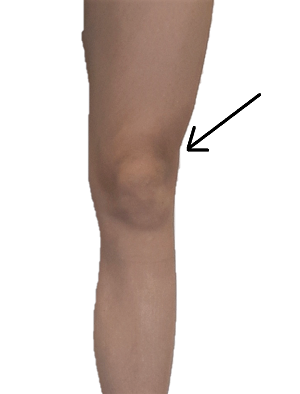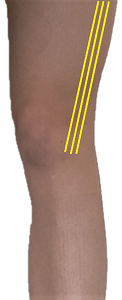
Illiotibial (IT) Band Syndrome
What is Illiotibial (IT) Band Syndrome?
First, it is important to know about the Illiotibial (IT) band. The IT band It is a structure that connects to muscles around the outside of the hip, and to the outside of the lower leg (tibia). It is affected with both knee and hip motions. Illiotibial (IT) band syndrome occurs when there is irritation between the illiotibial (IT) band and the outside of the upper leg bone (lateral femoral condyle).
Causes of Illiotibial (IT) Band Syndrome
Mechanics

Because structures are connected in the body, the mechanics of the foot can affect the IT band.
Foot pronation (rolling in/collapse) rotates the lower leg (tibia) and upper leg (femur) inwards. With this internal rotation, the IT band is excessively pulled. Like an elastic band, when the IT band is pulled, there is more tension at the band, creating pain over the bone at the outside of the knee joint. Combining this with activity can also exaggerate the pain.
Foot supination (rolling out) also leads to IT band syndrome, as the lower (tibia) and upper (femur) leg rotates out. Outwards rotation also causes pull to the IT band, leading to pain at the knee.
The angle at the leg can also be affected by structures higher up. If there are imbalances or structural deformities higher up, this can also affect the angle at the knee, leading to a tightened IT band.
Other
Tight or imbalanced muscles can lead to IT band syndrome when it leads to tightening of the IT band. The muscles that have a bigger impact to the IT band are the muscles that the IT band connects to around the hip joint (tensor fascia lata and gluteus maximus). Because the IT band is not a muscle, it does not contract like a muscle, but it can be pulled by the connecting muscles. If any of these are tight, it can make a large impact to the tightness of the IT band.
A combination of the above factors, plus repetitive motion of the knee joint when the knee and hip are flexed (ex. cycling), can all lead to pain from IT band syndrome.

What will I see and feel?
Pain from IT band syndrome is typically felt on the outside of the knee. This knee pain can be exaggerated with knee flexion and extension, and during activities such as running and cycling. On the outside of the knee, there may also be swelling and a popping noise or feeling when bending the knee.
Pedorthic Treatments/Prevention
Orthotics
Support from custom orthotics or over the counter inserts can help with IT band syndrome. They deal with the mechanical factors leading to abnormal rotation of the lower (tibia) and upper (femur) leg that tighten the IT band.
Footwear
Footwear is important for IT band syndrome to complement the orthotics and prevent additional excessive motion. A neutral running shoe is typically recommended for a supinator, or a pronator with supportive inserts. A stability runner is typically recommended for a pronator without supportive inserts, or in specific cases when a supportive insert is present. When you receive a supportive insert, check with your provider to see what shoe would be best for you!
Other
Physiotherapy helps to address any muscle tightness or imbalance issues. A combination of pedorthic treatments and physiotherapy may be necessary. Over time, abnormal foot mechanics can lead to muscle tightness and imbalances that need to be addressed.
If it sounds like a condition you have, or you would like more information, feel free to contact us!

You must be logged in to post a comment.